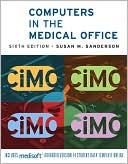Computers in the Medical Office
Search in google:
Computers in the Medical Office 6e is the best-selling text for training students using full-featured and current Medisoft Version 14 Patient Billing software. McGraw-Hill publishes the most titles to train students on Medisoft software. Our publishing relationship with Medisoft has been ongoing for 15 years. Computers in the Medical Office 6e offers medical office training using current, realistic medical office cases while building transferable computerized medical billing and scheduling skills. Students who complete this course will learn the appropriate terminology and skills to use any patient billing software program with minimal additional training. As students progress through Medisoft, they learn to gather patient information, schedule appointments and enter transactions. The practical, systematic approach is based on real-world medical office activities. Go with the best. Go with the tried and true. Go with the Medisoft titles that will give you and your students the training and support you need to be successful. Go with McGraw-Hill's Computers in the Medical Office 6e.
PART 1 INTRODUCTION TO COMPUTERS IN THE MEDICAL OFFICEChapter 1 The Medical Office Billing ProcessStep 1 Preregister PatientsStep 2 Establish Financial Responsibility for VisitStep 3 Check in PatientsStep 4 Check Out PatientsStep 5 Review Coding ComplianceStep 6 Check Billing ComplianceStep 7 Prepare and Transmit ClaimsStep 8 Monitor Payer AdjudicationStep 9 Generate Patient StatementsStep 10 Follow up Patient Payments and Handle Collections Chapter 2 Information Technology and HIPAAMedical Office ApplicationsElectronic Medical RecordsElectronic PrescribingPractice Management Advantages of Computer UseA Note of Caution: What Computers Cannot DoHIPAA and Electronic Exchange of Information HIPAA Electronic Transaction and Code Sets StandardsPrivacy RequirementsSecurity RequirementsPART 2 MEDISOFT ADVANCED TRAININGChapter 3 Introduction to MedisoftWhat is Medisoft?How Medisoft Data are Organized and StoredMedisoft DatabasesThe Student Data TemplateThe Medisoft Menu BarExercise 3-1The Medisoft ToolbarExercise 3-2Entering and Editing DataChanging the Medisoft Program DateExercise 3-3Saving DataDeleting DataUsing Medisoft HelpExercise 3-4Exercise 3-5Exiting MedisoftMaking a Backup File While Exiting Medisoft Exercise 3-6Restoring the Backup FileFile Maintenance UtilitiesRebuilding IndexesPacking DataPurging DataRecalculating Patient BalancesCHAPTER 4 Entering Patient InformationHow Patient Information is Organized in MedisoftEntering New Patient InformationName, Address TabExercise 4-1Other Information TabPayment Plan TabExercise 4-2Adding an Employer to the Address ListExercise 4-3Editing Patient InformationSearching for Patient InformationSearch for and Field OptionExercise 4-4Locate Buttons OptionExercise 4-5On Your Own ExercisesOn Your Own Exercise 1: Entering a New PatientChapter 5 Entering Insurance, Account, and Condition InformationWorking with CasesWhen to Set Up a New CaseCase Command ButtonsCreating a New Case for a New PatientPersonal TabExercise 5-1Account TabExercise 5-2Diagnosis TabExercise 5-3Policy 1 TabExercise 5-4Policy 2 TabPolicy 3 TabCondition TabExercise 5-5Miscellaneous TabMedicaid and Tricare TabComment TabEDI TabEditing Case Information on an Established PatientExercise 5-6On Your Own Exercise 2: Creating a Case for a New PatientChapter 6 Entering Charge Transactions and Patient PaymentsTransaction Entry OverviewPatient/Account Information ChartCaseTotals and Charge TabsCharge TransactionsButtons in the Charges Area of the Transaction Entry Dialog BoxSaving ChargesEditing TransactionsColor Coding in Transaction EntryExercise 6-1Exercise 6-2Payment/Adjustment TransactionsEntering Payments Made During Office VisitsSaving Paymenet InformationExercise 6-3Exercise 6-4Printing Walkout ReceiptsExercise 6-5Entering AdjustmentsExercise 6-6On Your Own Exercise 3: Enter Procedure Charges and a Patient PaymentOn Your Own Exercise 4: Print a Walkout ReceiptChapter 7 Creating ClaimsIntroduction to Health Care ClaimsCreating ClaimsCreate Claims Dialog BoxExercise 7-1Claim SelectionEditing ClaimsCarrier 1 TabCarrier 2 and Carrier 3 TabsTransactions TabComment TabExercise 7-2Electronic ClaimsSteps in Submitting Electronic ClaimsSending Electronic Claim AttachmentsChanging the Status of ClaimsExercise 7-3On Your Own Exercise 5: Create Insurance ClaimsChapter 8 Posting Insurance Payments and Creating Patient StatementsThird-Party Reimbursement OverviewIndemnity Plan ExampleMangaged Care ExampleMedicare Participating ExampleRemittance Advice (RA) ProcessingSteps for Processing a Remittance AdviceEntering Insurance Carrier Payments in MedisoftEntering Insurance PaymentsApplying Insurance Payments to ChargesExercise 8-1Exercise 8-2Exercise 8-3Entering Capitation Payments and AdjustmentsExercise 8-4Exercise 8-5Creating Statements Statement Management Dialog BoxCreate Statements Dialog BoxExercise 8-6Editing StatementsGeneral TabTransactions TabComment TabExercise 8-7Printing StatementsSelecting a FormatSelecting the Filters and Printing StatementsExercise 8-8On Your Own Exercise 6: Enter Insurance PaymentsOn Your Own Exercise 7: Create StatementsChapter 9 Printing ReportsReports in the Medical OfficeDay SheetsExercise 9-1Exercise 9-2Exercise 9-3Analysis ReportsExercise 9-4Aging ReportsExercise 9-5Collection ReportsPatient Ledger ReportsExercise 9-6Standard Patient ListsCustom ReportsExercise 9-7Exercise 9-8Using Report DesignerExercise 9-9On Your Own Exercise 8: Print a Patient Day SheetOn Your Own Exercise 9: Print a Practice Analysis ReportChapter 10: Collections in the Medical OfficeThe Importance of Collections in the Medical PracticeThe Patient Collection Process Laws Governing Timely Payment of Insurance ClaimsUsing a Practice Management Program for Collections ActivitiesExercise 10-1Using the Collection List Entering a Tickler ItemExercise 10-2Creating Collection LettersExercise 10-3Printing a Collection Tracer ReportExercise 10-4On Your Own Exercise 10: Print a Patient Aging Applied ReportOn Your Own Exercise 11: Add an Item to the Work ListOn Your Own Exercise 12: Create a Collection LetterChapter 11 SchedulingIntroduction to Office HoursOverview of the Office Hours WindowProgram OptionsEntering and Exiting Office HoursEntering AppointmentsLooking for a Future DateExercise 11-1Exercise 11-2Exercise 11-3Exercise 11-4Searching for Available Appointment TimeExercise 11-5Exercise 11-6Entering Appointments for New PatientsExercise 11-7Booking Repeated AppointmentsExercise 11-8Changing or Deleting AppointmentsExercise 11-9Creating a Recall ListAdding a Patient to the Recall ListExercise 11-10Creating BreaksExercise 11-11Previewing and Printing SchedulesExercise 11-12On Your Own Exercise 13: Enter an AppointmentOn Your Own Exercise 14: Change an AppointmentOn Your Own Exercise 15: Print a Physician SchedulePART 3 APPLYING YOUR KNOWLEDGEChapter 12 Handling Patient Records and TransactionsExercise 12-1: Inputting Patient InformationExercise 12-2: An Emergency VisitExercise 12-3: Inputting Transaction DataExercise 12-4: Entering a New Patient and TransactionsExercise 12-5: Entering and Applying an Insurance Carrier PaymentChapter 13 Setting Up AppointmentsExercise 13-1: Scheduling AppointmentsExercise 13-2: Making an Appointment ChangeExercise 13-3: Juggling SchedulesExercise 13-4: Adding Patients to the Recall ListExercise 13-5: Diane Hsu and Michael SyzmanskiExercise 13-6: Changing a Transaction RecordChapter 14 Printing Lists and ReportsExercise 14-1: Finding a Patient’s BalanceExercise 14-2: Printing a ScheduleExercise 14-3: Printing Day Sheet ReportsExercise 14-4: Creating a Patient Aging Applied Payment ReportExercise 14-5: Adding Items to the Work ListExercise 14-6: Creating a Practice Analysis ReportExercise 14-7: Stewart RobertsonExercise 14-8: Michael SyzmanskiChapter 15 Putting it all TogetherExercise 15-1: Scheduling AppointmentsExercise 15-2: Creating CasesExercise 15-3: Entering TransactionsExercise 15-4: Creating ClaimsExercise 15-5: Entering Insurance PaymentsExercise 15-6: Creating Patient StatementsExercise 15-7: Printing ReportsExercise 15-8: Adding Items to the Collection ListExercise 15-9: Creating Collection LettersPART 4 SOURCE DOCUMENTSGlossaryIndex








